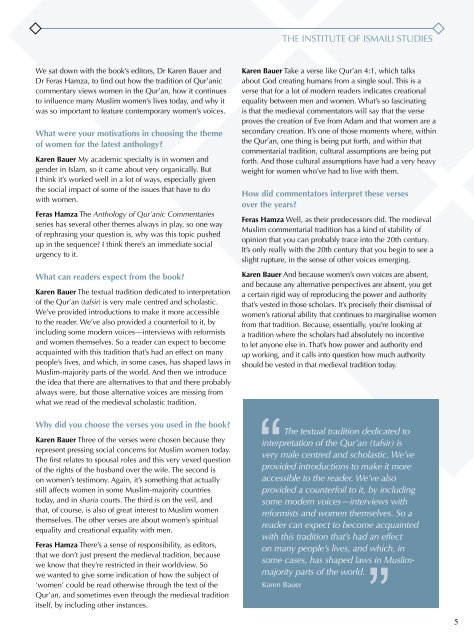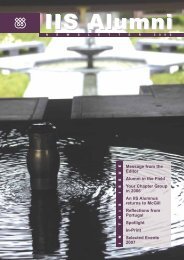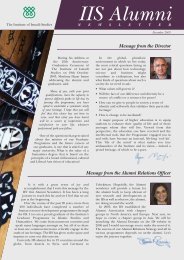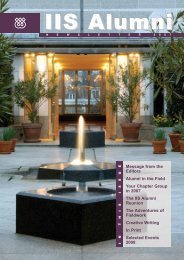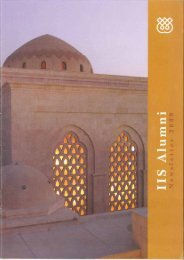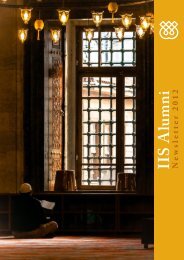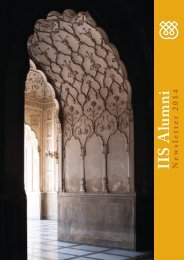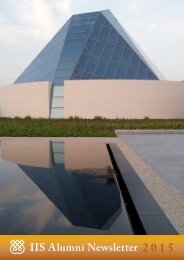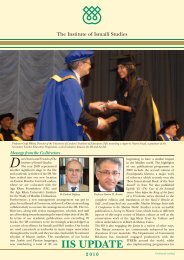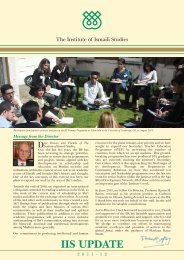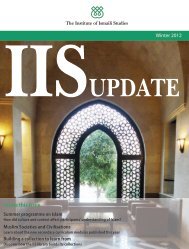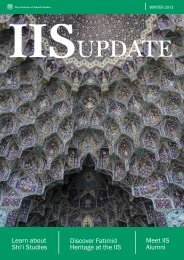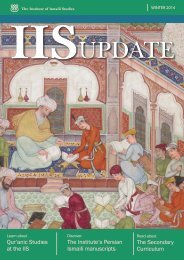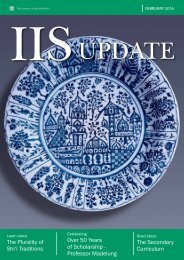IIS UPDATE Magazine Edition 20
You also want an ePaper? Increase the reach of your titles
YUMPU automatically turns print PDFs into web optimized ePapers that Google loves.
THE INSTITUTE OF ISMAILI STUDIES<br />
We sat down with the book’s editors, Dr Karen Bauer and<br />
Dr Feras Hamza, to find out how the tradition of Qur’anic<br />
commentary views women in the Qur’an, how it continues<br />
to influence many Muslim women’s lives today, and why it<br />
was so important to feature contemporary women’s voices.<br />
What were your motivations in choosing the theme<br />
of women for the latest anthology?<br />
Karen Bauer My academic specialty is in women and<br />
gender in Islam, so it came about very organically. But<br />
I think it’s worked well in a lot of ways, especially given<br />
the social impact of some of the issues that have to do<br />
with women.<br />
Feras Hamza The Anthology of Qur’anic Commentaries<br />
series has several other themes always in play, so one way<br />
of rephrasing your question is, why was this topic pushed<br />
up in the sequence? I think there’s an immediate social<br />
urgency to it.<br />
What can readers expect from the book?<br />
Karen Bauer The textual tradition dedicated to interpretation<br />
of the Qur’an (tafsir) is very male centred and scholastic.<br />
We’ve provided introductions to make it more accessible<br />
to the reader. We’ve also provided a counterfoil to it, by<br />
including some modern voices—interviews with reformists<br />
and women themselves. So a reader can expect to become<br />
acquainted with this tradition that’s had an effect on many<br />
people’s lives, and which, in some cases, has shaped laws in<br />
Muslim-majority parts of the world. And then we introduce<br />
the idea that there are alternatives to that and there probably<br />
always were, but those alternative voices are missing from<br />
what we read of the medieval scholastic tradition.<br />
Why did you choose the verses you used in the book?<br />
Karen Bauer Three of the verses were chosen because they<br />
represent pressing social concerns for Muslim women today.<br />
The first relates to spousal roles and this very vexed question<br />
of the rights of the husband over the wife. The second is<br />
on women’s testimony. Again, it’s something that actually<br />
still affects women in some Muslim-majority countries<br />
today, and in sharia courts. The third is on the veil, and<br />
that, of course, is also of great interest to Muslim women<br />
themselves. The other verses are about women’s spiritual<br />
equality and creational equality with men.<br />
Feras Hamza There’s a sense of responsibility, as editors,<br />
that we don’t just present the medieval tradition, because<br />
we know that they’re restricted in their worldview. So<br />
we wanted to give some indication of how the subject of<br />
‘women’ could be read otherwise through the text of the<br />
Qur’an, and sometimes even through the medieval tradition<br />
itself, by including other instances.<br />
Karen Bauer Take a verse like Qur’an 4:1, which talks<br />
about God creating humans from a single soul. This is a<br />
verse that for a lot of modern readers indicates creational<br />
equality between men and women. What’s so fascinating<br />
is that the medieval commentators will say that the verse<br />
proves the creation of Eve from Adam and that women are a<br />
secondary creation. It’s one of those moments where, within<br />
the Qur’an, one thing is being put forth, and within that<br />
commentarial tradition, cultural assumptions are being put<br />
forth. And those cultural assumptions have had a very heavy<br />
weight for women who’ve had to live with them.<br />
How did commentators interpret these verses<br />
over the years?<br />
Feras Hamza Well, as their predecessors did. The medieval<br />
Muslim commentarial tradition has a kind of stability of<br />
opinion that you can probably trace into the <strong>20</strong>th century.<br />
It’s only really with the <strong>20</strong>th century that you begin to see a<br />
slight rupture, in the sense of other voices emerging.<br />
Karen Bauer And because women’s own voices are absent,<br />
and because any alternative perspectives are absent, you get<br />
a certain rigid way of reproducing the power and authority<br />
that’s vested in those scholars. It’s precisely their dismissal of<br />
women’s rational ability that continues to marginalise women<br />
from that tradition. Because, essentially, you’re looking at<br />
a tradition where the scholars had absolutely no incentive<br />
to let anyone else in. That’s how power and authority end<br />
up working, and it calls into question how much authority<br />
should be vested in that medieval tradition today.<br />
The textual tradition dedicated to<br />
interpretation of the Qur’an (tafsir) is<br />
very male centred and scholastic. We’ve<br />
provided introductions to make it more<br />
accessible to the reader. We’ve also<br />
provided a counterfoil to it, by including<br />
some modern voices—interviews with<br />
reformists and women themselves. So a<br />
reader can expect to become acquainted<br />
with this tradition that’s had an effect<br />
on many people’s lives, and which, in<br />
some cases, has shaped laws in Muslimmajority<br />
parts of the world.<br />
Karen Bauer<br />
5


